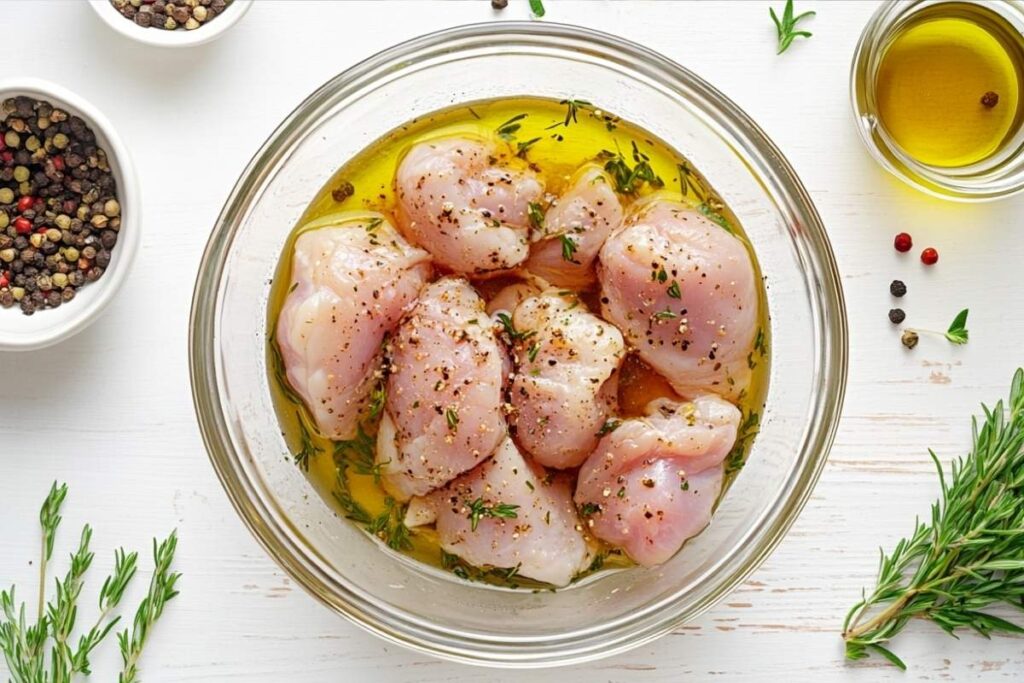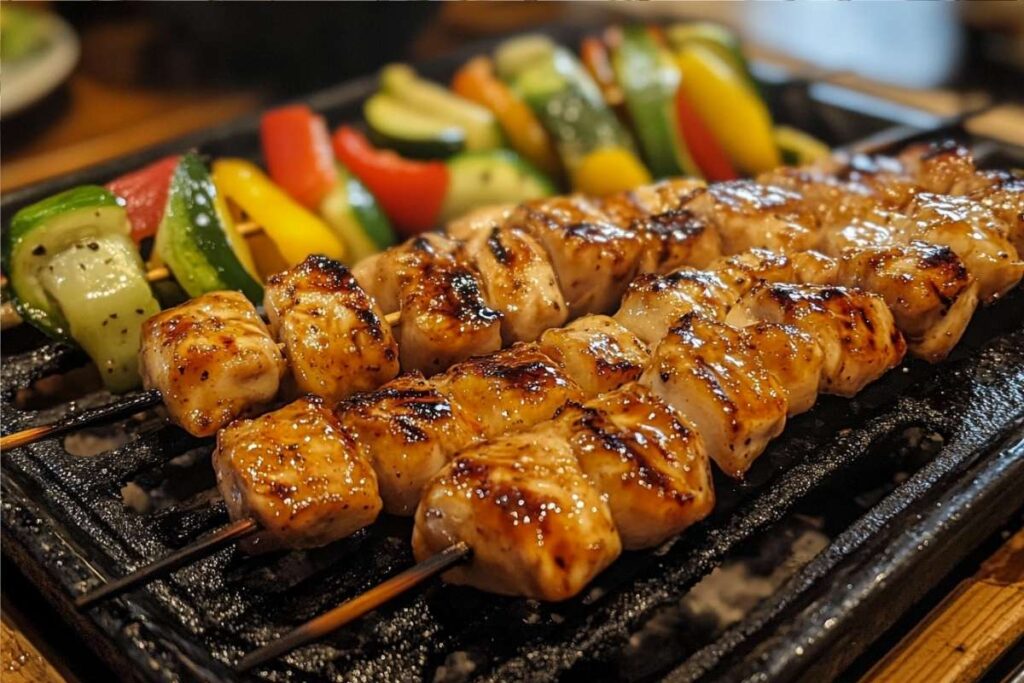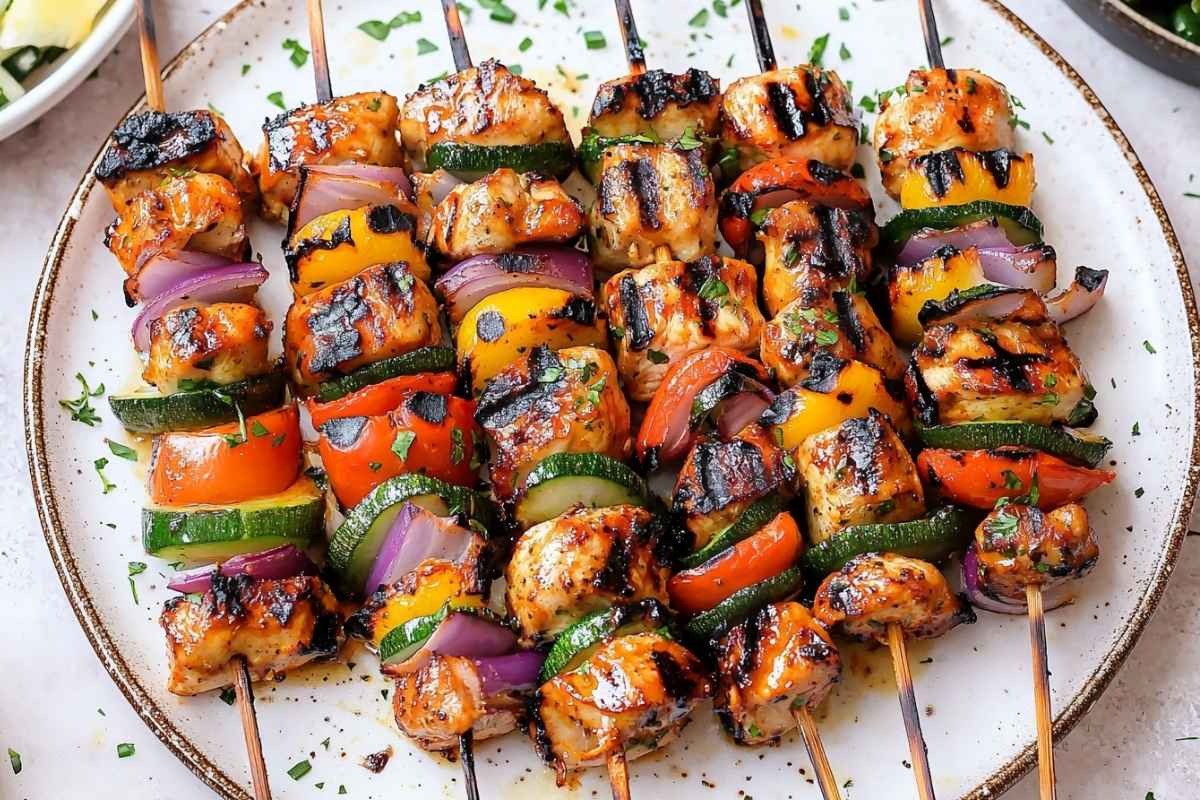Chicken skewers are a crowd favorite for barbecues, weeknight dinners, and even quick air-fried meals. But let’s face it—getting perfectly juicy chicken skewers isn’t always a walk in the park. Many home cooks struggle with the big question: how to not overcook chicken skewers? Overcooked chicken can be dry and flavorless, but with the right techniques, you can make skewers that are tender and full of flavor every time.
In this article, we’ll dive into why overcooking happens, how to prevent it, and expert cooking tips for grilling, baking, and air-frying chicken skewers. From choosing the right cut of chicken to marinating techniques and temperature guidelines, you’ll learn everything you need to make tender, juicy skewers every single time..
Whether you’re new to cooking or a seasoned grill master, this guide will ensure your chicken skewers are always cooked to perfection. Let’s get started!
The Importance of Properly Cooked Chicken Skewers
Why Overcooking Chicken is a Common Problem
Chicken is a lean protein, which makes it highly prone to drying out when exposed to excessive heat for too long. Cuts like chicken breasts are especially vulnerable due to their low fat content, while thighs are slightly more forgiving. Overcooking often happens because cooks are either too cautious about undercooking (leading to extra cooking time) or use high heat without proper monitoring.
Another common mistake? Uneven cuts of chicken. Skewers with different-sized pieces often cook unevenly, leaving some chunks overcooked while others remain raw.
Risks of Undercooking and Overcooking Chicken Skewers
Undercooked chicken poses health risks due to bacteria like salmonella and campylobacter. That’s why ensuring the internal temperature reaches 165°F (74°C) is crucial. On the flip side, overcooking can turn a juicy skewer into a dry, rubbery mess that’s tough to chew and lacks flavor.
Properly cooked chicken skewers strike the perfect balance—they’re safe to eat, full of flavor, and have just the right tenderness. If you want foolproof results, understanding the science behind cooking chicken is the first step.
Understanding Chicken Skewer Cooking Basics
How Heat Affects Chicken Texture and Juiciness
Cooking chicken skewers to perfection requires a clear understanding of how heat interacts with the meat. If you’ve ever wondered how to not overcook chicken skewers, the key lies in balancing heat and timing. Using consistent, moderate heat ensures juicy, tender meat without drying it out.
Using consistent, moderate heat is essential for retaining juiciness and ensuring even cooking. When cooking chicken skewers, it’s crucial to balance time and temperature for the best results. This makes knowing your cooking method—grilling, baking, or air frying—important in determining how much heat to apply and for how long.
Why Even Cooking is Critical for Chicken Skewers
Uneven cooking is a common issue that occurs when chicken pieces are cut into inconsistent sizes. Larger pieces require more time to cook, while smaller chunks can become overcooked in the process. For skewer success, always aim to cut the chicken into uniform, bite-sized pieces.
Proper skewer assembly also plays a vital role. Leaving slight gaps between each piece allows heat to circulate more evenly, ensuring that every bite is cooked to perfection. This is especially critical for recipes like Bang Bang Chicken Skewers, where a balance of flavor and texture is key.
Choosing the Right Chicken Cut to Avoid Overcooking
Chicken Thighs vs. Breasts for Juicy Skewers
When considering how to not overcook chicken skewers, selecting the right cut of chicken is half the battle. Chicken thighs are a top choice because their higher fat content keeps them moist, even under prolonged cooking times. They’re forgiving, making them ideal for grilling or high-heat methods.
On the other hand, chicken breasts are leaner and cook faster, which means they can dry out if overcooked. To ensure success with breasts, marination is key. A yogurt or oil-based marinade can lock in moisture, allowing them to shine in dishes like Melt-In-Your-Mouth Chicken.
Why Uniform Chicken Cuts Help Prevent Overcooking
Unevenly cut chicken pieces lead to uneven cooking, with smaller chunks drying out while larger ones remain raw. Whether you’re using thighs or breasts, aim for 1- to 1.5-inch cubes for consistent cooking. Recipes like Empress Chicken often emphasize this preparation step to achieve balanced, flavorful results.
Additionally, trimming excess fat or connective tissue ensures that your skewers cook evenly, preventing unpleasant textures and flavors. The right preparation makes all the difference in keeping chicken skewers juicy and flavorful.
Marinating Techniques for Juicy Chicken Skewers
Why Marination Prevents Overcooking

Marinating is more than just a flavor booster—it’s a key step in learning how to not overcook chicken skewers. A good marinade creates a protective barrier that locks in moisture while adding depth to the flavor.
Acidic components such as lemon juice or vinegar break down tough fibers in the meat, ensuring it stays tender even under high heat. Additionally, the fat in the marinade adds richness, making the chicken both juicy and flavorful. For a great example of this technique, check out the tangy and flavorful marinade used in the Sweet Hawaiian Crockpot Chicken Recipe.
Best Ingredients for Effective Marination
A good marinade balances three essential components: fat, acid, and seasoning. Here’s how they work together:
- Fat: Olive oil, coconut milk, or yogurt helps retain moisture.
- Acid: Lemon juice, vinegar, or soy sauce breaks down protein fibers for a tender texture.
- Seasoning: Garlic, paprika, herbs, and spices elevate the flavor profile.
Let the chicken marinate for at least 30 minutes, but if time allows, overnight marination enhances both texture and flavor. For recipes like Bang Bang Chicken Skewers, a spicy and creamy marinade ensures rich, irresistible results.
Cooking Methods for Perfect Chicken Skewers
Grilling Chicken Skewers Without Overcooking

Grilling is a classic method for chicken skewers, but it’s also where overcooking happens most frequently. To avoid this, preheat your grill to medium-high heat and lightly oil the grates to prevent sticking. Cook the skewers for about 10-12 minutes, turning frequently to ensure even charring.
Using a meat thermometer is crucial. The internal temperature of the chicken should reach 165°F (74°C). Pull the skewers off the grill immediately once they hit this target to prevent overcooking.
If you enjoy grilled flavors, recipes like Melt-In-Your-Mouth Chicken demonstrate how to balance juiciness with that signature smoky taste.
Baking and Air Frying Chicken Skewers
For baking, preheat the oven to 400°F and place the skewers on a lined baking sheet. Cook for 20-25 minutes, flipping halfway through to ensure even browning. The oven’s consistent heat reduces the risk of uneven cooking.
Air frying is another fantastic option for achieving crispy exteriors while keeping the meat tender. Set the air fryer to 375°F and cook for 10-12 minutes, shaking the basket halfway through. This method is perfect for quick, weeknight meals when you’re short on time.
Whichever method you choose, remember: timing and temperature are everything.
Common Mistakes When Cooking Chicken Skewers
Using High Heat Without Monitoring
One of the biggest mistakes when learning how to not overcook chicken skewers is using excessively high heat without keeping a close watch. While high heat helps achieve those beautiful grill marks, it can quickly dry out the chicken, especially lean cuts like breasts. To avoid this, always aim for medium to medium-high heat and keep a meat thermometer handy to track progress.
Overcrowding Skewers or the Cooking Surface
Another common issue is overcrowding. Whether it’s packing too much on a single skewer or cramming the grill or oven tray, overcrowding blocks proper airflow. This causes uneven cooking, leaving some chicken pieces dry while others are undercooked. Always space out chicken pieces on the skewer and give each skewer enough room for heat to circulate.
Skipping Resting Time After Cooking
After cooking chicken skewers, it’s tempting to serve them immediately. However, skipping resting time is a rookie mistake! Resting the skewers for 5-10 minutes allows the juices to redistribute, ensuring moist, flavorful chicken in every bite. For perfectly cooked skewers, patience truly pays off.
Temperature Guidelines and Tools for Preventing Overcooking
The Ideal Internal Temperature for Juicy Chicken Skewers
Undercooked chicken poses health risks due to bacteria like salmonella and campylobacter. That’s why ensuring the internal temperature reaches 165°F (74°C) is crucial, as outlined by the USDA Food Safety Guidelines.
How to Use Meat Thermometers Effectively
Investing in a reliable meat thermometer is one of the best ways to prevent overcooking. Insert the thermometer into the thickest piece of chicken on the skewer to check its temperature. Avoid placing the probe too close to the skewer stick, as it may give an inaccurate reading due to heat conduction from the skewer itself.
Digital instant-read thermometers are particularly helpful for grilling or air-frying, where precision matters. If you’re new to this tool, consider using it on recipes like Bang Bang Chicken Skewers, where timing and texture are crucial.
Tips for Maintaining Heat Control on a Grill or Oven
Maintaining consistent heat is essential for evenly cooked chicken skewers. When grilling, preheat the grill and adjust the flame to ensure steady heat throughout the cooking process. For ovens, use a thermometer to monitor internal temperature accuracy, as some ovens can have hot spots.
By combining proper tools and techniques, you can achieve perfectly cooked chicken skewers every time!
Expert Tips for Cooking Skewers Evenly Every Time
Using Basting During Cooking to Retain Moisture
Basting is an excellent way to keep chicken skewers juicy throughout the cooking process. By brushing the chicken with oil, melted butter, or a flavorful marinade during cooking, you add an extra layer of moisture that prevents the meat from drying out. For example, basting with a honey-soy glaze halfway through grilling enhances both flavor and tenderness.
Rotating Skewers for Even Heat Distribution
Uneven cooking often happens when skewers are left on one side for too long. To avoid this, rotate the skewers frequently, ensuring all sides get equal exposure to heat. If you’re grilling, a quarter-turn every 2-3 minutes is a simple trick that works wonders.
How to Combine Vegetables Without Overcooking the Chicken
When pairing chicken with vegetables on a skewer, choose veggies that cook at similar rates, like bell peppers, zucchini, and mushrooms. If using firmer vegetables, such as potatoes, par-cook them before assembling the skewers. This strategy ensures that everything is perfectly cooked by the time the chicken reaches its ideal temperature.
By following these expert tips, you’ll never have to wonder how to not overcook chicken skewers again!
FAQs About Cooking Chicken Skewers
How to Keep Chicken Skewers from Drying Out?
Marination is the key to juicy chicken skewers. Ingredients like yogurt, olive oil, or lemon juice lock in moisture. Additionally, basting during cooking and using medium heat help retain juiciness.
How Do You Not Overcook Chicken on the Grill?
Start by preheating the grill to medium-high heat. Use a meat thermometer to monitor the chicken’s internal temperature, removing it from heat once it reaches 165°F (74°C). Rotate skewers regularly for even cooking.
Why Do Chicken Skewers Take So Long to Cook?
Chicken skewers can take longer to cook if the chicken pieces are too large or uneven. Overcrowding on the grill or insufficient heat circulation can also cause delays. Cut chicken into uniform sizes and maintain proper spacing for quicker, even cooking.
How Do You Cook Skewers Evenly?
To cook skewers evenly, cut chicken and vegetables into similar-sized pieces. Leave small gaps between items on the skewer, rotate frequently, and ensure consistent heat throughout the cooking process.
Would you like any adjustments or additional details before wrapping up the article? 😊

